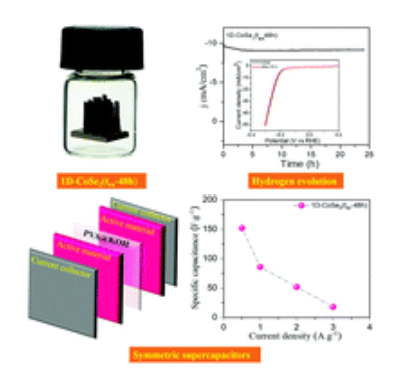1D-CoSe2 nanoarray: a designed structure for efficient hydrogen evolution and symmetric supercapacitor characteristics
- 저자
- Iqra Rabani, Sajjad Hussain*, Dhanasekaran Vikraman*, Young-Soo Seo, Jongwan Jung*, Atanu Jana*, Nabeen K. Shrestha*, Mohammed Jalalah, Yong-Young Noh*, Supriya A. Pati*l
- 저널명
- Dalton Transactions, 49, 14191 (2020)
- 년도
- 2020
- Link
- https://doi.org/10.1039/D0DT02548H 453회 연결
[Abstract]
Direct growth of self-supported one-dimensional (1D) nanorod arrays on conducting substrates is highly attractive for electrocatalysis, due to their unique shape, size, and length. In this work, a facile and simple two-step method was employed to synthesize 1D-CoSe2 nanoarrays on titanium (Ti) foil via a wet chemical ion-exchange approach. The as-synthesized 1D-CoSe2 nanoarrays were directly used as electrode materials for hydrogen evolution reaction and supercapacitors. As an electrocatalyst, the optimized 1D-CoSe2(tex-48 h) nanoarray exhibits excellent hydrogen evolution properties with a small Tafel slope of 78 mV dec−1, low overpotentials of 41 mV@1 mA cm−2 and 216 mV@10 mA cm−2, and extended robust performance for 25 h. Moreover, for a symmetric device, it delivers a maximum specific capacitance of 152 F g−1 at 0.5 A g−1 and a better energy density of 21.1 W h kg−1 at a power density of 0.5 kW kg−1. Also, the symmetric device capacity retention behavior achieves ∼96.8% of the initial result after 5000 cycles, revealing the good stability of the electrode. Our findings offer a new way to further the development of high-performance energy devices.
